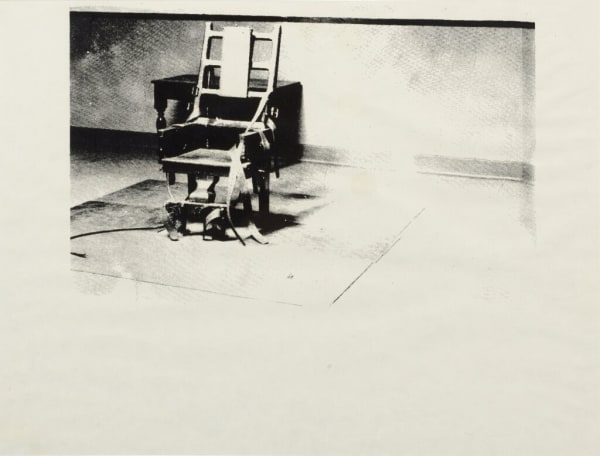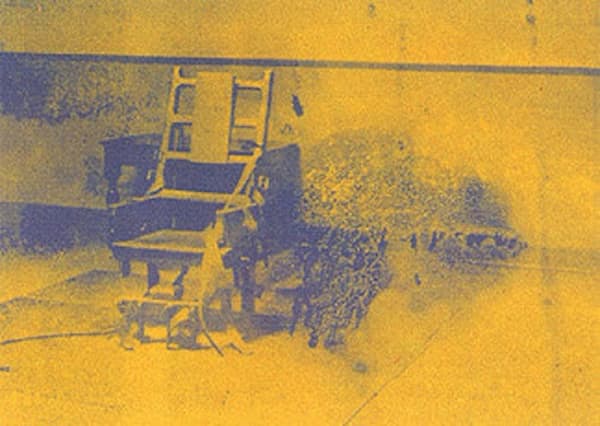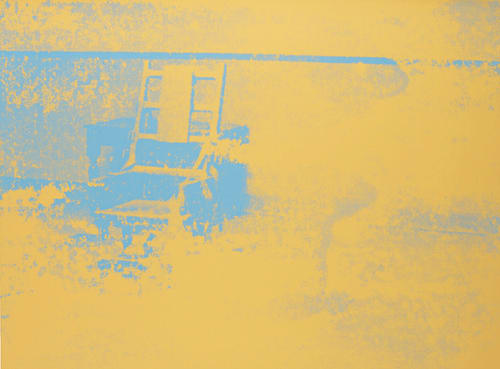
Andy Warhol
88.9 x 121.9 cm (each)
Andy Warhol's Electric Chairs are part of the portfolio of ten screen prints from 1971 is a somber and thought-provoking exploration of mortality, violence, and the spectacle of death in American culture. Inspired by photographs of the electric chair, a symbol of capital punishment in the United States, Warhol's series confronts viewers with the stark reality of state-sanctioned violence while also interrogating the role of mass media in desensitizing society to human suffering.
Each print in the Electric Chair portfolio depicts a lone electric chair against a plain background, rendered in Warhol's signature style of bold colors and simplified shapes. Despite the absence of human figures, the empty chair carries a weighty symbolism, evoking a sense of foreboding and existential dread. Warhol's use of repetition further emphasizes the impersonal and mechanical nature of the execution process, suggesting a sense of detachment and dehumanization.
The Electric Chair portfolio (FS II.74-83) was created during a tumultuous period in American history, marked by social unrest, political upheaval, and widespread disillusionment with authority. Against this backdrop, Warhol's series serves as a powerful critique of the state's use of violence as a means of control and punishment, as well as the voyeuristic fascination with death perpetuated by the media.
Despite its unsettling subject matter, the Electric Chair (FS II.74-83) portfolio is also a testament to Warhol's artistic vision and technical mastery. The series exemplifies Warhol's ability to transform everyday objects and images into iconic symbols, challenging viewers to confront uncomfortable truths about society and the human condition.
Authenticating and acquiring prints from Andy Warhol's Electric Chair portfolio requires careful consideration to ensure both the authenticity of the artwork and the safety of the transaction. Researching reputable sources, verifying the provenance and authenticity of the prints, and using secure payment methods are essential steps in acquiring Warhol prints safely and responsibly.
Through his Electric Chair (FS II.74-83) portfolio, Andy Warhol invites viewers to contemplate the profound implications of violence and mortality in contemporary society, challenging us to confront uncomfortable truths about power, justice, and the human experience.
For more information on Andy Warhol’s Electric Chairs for sale or to buy Electric Chairs, contact our galleries using the form below.-
 Andy WarholElectric Chair, 1971
Andy WarholElectric Chair, 1971 -
 Andy WarholElectric Chair (Retrospective Series) , 1978
Andy WarholElectric Chair (Retrospective Series) , 1978 -
 Andy WarholElectric Chair (Yellow), 1971
Andy WarholElectric Chair (Yellow), 1971 -
 Andy WarholElectric Chair F.S. IIIA 4 (B), 1978
Andy WarholElectric Chair F.S. IIIA 4 (B), 1978 -
 Andy WarholElectric Chair F.S. IIIA 4 (A), 1978
Andy WarholElectric Chair F.S. IIIA 4 (A), 1978 -
 Andy WarholElectric Chair F.S. II 78, 1971
Andy WarholElectric Chair F.S. II 78, 1971 -
 Andy WarholElectric Chair F.S. II 81, 1971
Andy WarholElectric Chair F.S. II 81, 1971 -
 Andy WarholElectric Chair F.S. II 74, 1971
Andy WarholElectric Chair F.S. II 74, 1971 -
 Andy WarholElectric Chair F.S. II 75, 1971
Andy WarholElectric Chair F.S. II 75, 1971 -
 Andy WarholElectric Chair F.S. II 80, 1971
Andy WarholElectric Chair F.S. II 80, 1971 -
 Andy WarholElectric Chair F.S. II 79, 1971
Andy WarholElectric Chair F.S. II 79, 1971 -
 Andy WarholElectric Chair F.S. II 82, 1971
Andy WarholElectric Chair F.S. II 82, 1971 -
 Andy WarholElectric Chair F.S. II 77, 1971
Andy WarholElectric Chair F.S. II 77, 1971 -
 Andy WarholElectric Chair F.S. II 76, 1971
Andy WarholElectric Chair F.S. II 76, 1971 -
 Andy WarholElectric Chair F.S. II 83, 1971
Andy WarholElectric Chair F.S. II 83, 1971 -
 Andy WarholFrom The Wonderful World of Fleming-Joffe, Alligator, 1960
Andy WarholFrom The Wonderful World of Fleming-Joffe, Alligator, 1960















